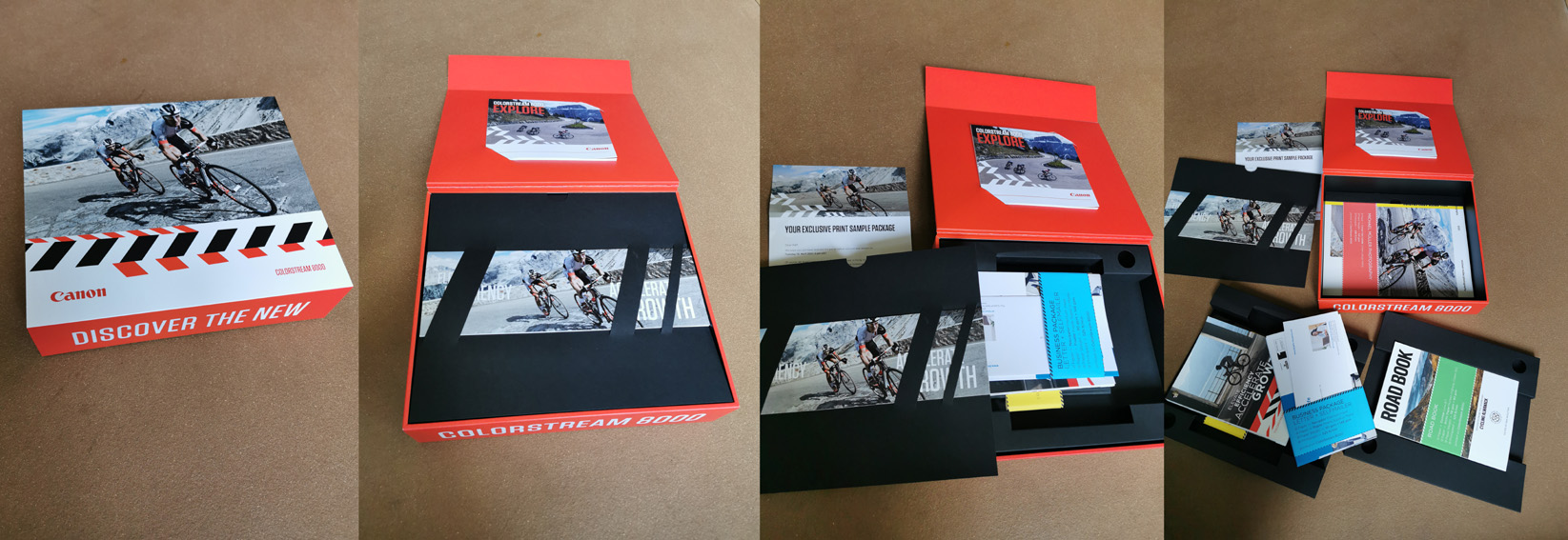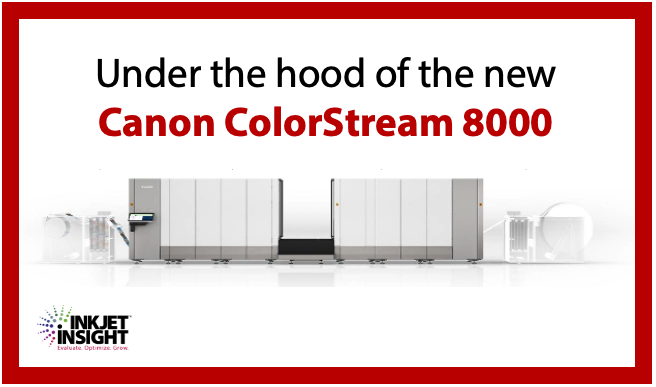Read the product release here.
Canon launches ColorStream 8000 series with “family keepsakes”
Not all product families have been as successful as the Canon ColorStream series. The first ColorStream model was built with the considerable expertise of Océ in webfed toner printers and transaction print at its core. The first in the series, the ColorStream 3500, was launched in 2010. In 2014 the second-generation Z-models followed, while at drupa 2016 the ColorStream 6000 series was introduced. So far there are more than 1,500 ColorStream installations worldwide.
With the ColorStream 8000 Canon plans to build on the strengths of the previous generations, while expanding the application range and productivity. The press has been in beta since 2020 at a German data centre printer and the device will be fully available in Europe and North America concurrently with the official launch this month.
Under the hood
There is a lot of good technology in the existing ColorStream family to keep. However, Canon improved several areas, most prominently speed and imaging resolution.
The most tangible improvement will be the higher speed of the 8000 series. There will be two models, the 8133 and the 8160 with 133 m/min and 160 m/min speed respectively. This results in 1,790 or 2,152 A4 images per minute, equalling a 25% improvement on the top speed model of the 6000 series. For the 8000 it is possible to upgrade the speed of the 8133 on site without hardware change. However, there is no upgrade path for existing 6000 series installations.
The ColorStream 6000 series relies on 600 dpi printheads. With the 8000, Canon moves into the 1,200 dpi league, although the resolution in web direction is lower. The new Kyocera 64 kHz gives the 8133 a 1,200 x 720 dpi resolution. With the higher speed of the 8160 the resolution goes down to 1,200 x 600 dpi. Even at the top speed this is a noticeable improvements on the previous top speed ColorStream model. The resolution of the ColorStream 6900 at full speed is only 600 x 480 dpi. Multilevel drop sizes from 2 to 5 pl are possible with the 8000.
Another interesting improvement is the increased paper weight range with improved performance at the lower end. The 8000 series allows printing on 40 gsm (27 # text) paper as a standard, which takes the paper range to 40 to 160 gsm. As with previous models printing on papers outside the range can be possible upon testing by Canon.
The print width has been extended slightly from 550 to 560 mm (21.7” to 22”), which can make a difference by allowing 4-up print of typical trade book formats.
There are some interesting smaller improvements as well, which could be easily overlooked. The new integrated web cleaner offers a new approach with a sticky roller and vacuum extraction for paper dust. It has the potential for uptime and quality improvements and could allow lower cost paper grades to be used as dust is managed in-line.
A new print head spray cleaning unit was incorporated to reduce manual tasks and ink usage. A cleaning liquid is sprayed onto the heads from underneath and a wiper blade removes the ink residues.
It almost goes without saying that the user interface has been upgraded on this new generation device. The controller has been upgraded as well and offers a scalable RIP architecture.
The ColorStream 8000 is prepared for 6 colour stations. At the moment the 5th and 6th colour stations can be equipped with MICR. When using both stations, MICR can be printed at full speed of 160 m/min, or with one station at half that speed. Specialty inks for security print can be realised as special customer projects, extended gamut inks are not planned for these models. For those needing less colour, e.g. in book printing, there is a mono version in development, which will become available later this year.
Print Quality in a Box
Canon sent analysts an elaborate sample box that will be hard to discard. The samples included show that they are confident about the imaging quality on a number of media, images types and binding/finishing options.
The prints show smooth colour areas and gradients, no banding or inkjet artefacts. Light tones blend to zero without appearing grainy. Colour strength is good, although not as good as a on high-end presses like the ProStream. There is good detail and small text is legible as well, even in the higher speed/lower resolution mode. Bound pieces look very good, without waviness.
The sample set included more than 15 papers from a variety of vendors. The focus for the ColorStream is on uncoated papers both offset and formulated for inkjet. Coated papers that have been formulated/optimised for inkjet should be possible as well, while high quality print on offset coated papers will require other family members like the varioPRINT iX and ProStream 1800.

Positioning and Outlook
The ColorStream 8000 series fits nicely into Canon’s inkjet production portfolio. It extends the ColorStream series into higher speeds and closes the gap with the top speed JetStream series. Filling this speed range seems more pressing than moving into even higher speeds, as few users have volumes to really exploit the JetStream series. Yet printers are interested in increasing their productivity to improve the cost base and consolidate volumes. The ColorStream 6000 will stay in the portfolio for lower volume users. The 8000 series will be higher priced than the 6000, Canon did not give any details on pricing.
Although the quality is good, the ColorStream 8000 is not intended for high-end graphic arts quality or papers. This slot in the Canon portfolio is filled by the ProStream and the sheetfed varioPRINT iX. Nevertheless, the higher imaging resolution, improved inks and other tweaks give the 8000 series easily the best quality of the ColorStream and JetStream families.

The ColorStream 8000 does extend the speed and productivity of the ColorStream 6000 series into higher volumes, especially as the 6900 had a relatively low resolution at full speed.
Combined with a higher image quality and extended paper range there should be a number of users willing to move to the 8000 series as well as some potential customers, which were not addressed before. The press has some interesting technical improvements in addition, which might trickle down into the other devices as well. For now, the 8000 has quite an edge on the ColorStream and JetStream devices in quality and automation.
Overall, the ColorStream 8000 is not a revolution, but a very helpful evolution of a successful concept. The device expands the print application range, lowers cost through improved productivity and automation and allows for higher value print by improving the quality. It is a welcome addition to the Canon inkjet family.


Comments
I was able to get one of these sample boxes and was blown away by the print quality that the 8000 delivers at such high print speeds. We once had to choose high quality or high speed but this really gives both on uncoated media and the slightly wider web width opens up new productivity for some applications, too. I think anyone who needs to produce a high volume of textbooks should be looking seriously at this new platform!